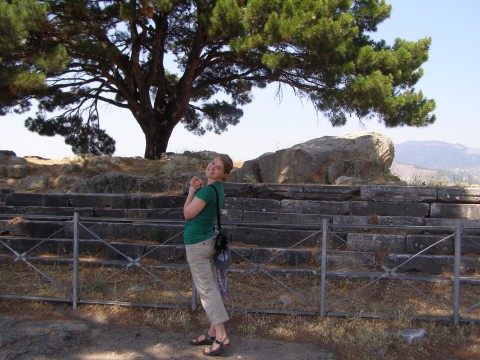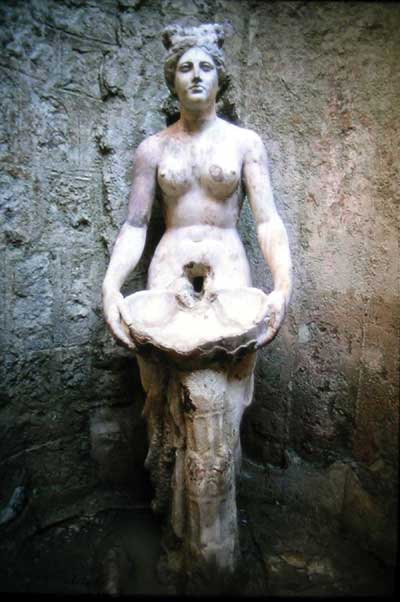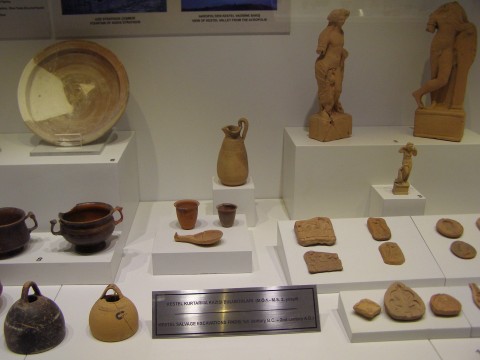Friday, June 29th, 2012
How to Cover Ancient Sites: Build Dams!
I’m back from my trip to Turkey! It was so neat to see Hagia Sophia, the Süleymaniye Mosque, the Anastasis painting in the Chora Church, Ephesus, Pergamon, the rock-cut churches of Cappadocia, and much more. I’m sure I’ll share photos and thoughts on the trip intermittently on this blog. I took hundreds of photos and learned a lot. But, like always, I left my trip feeling like I had a lot left to learn. I’m excited to follow up on the questions that were generated during my trip.

A highlight of the trip: seeing the original location for the Altar of Zeus at the acropolis of Pergamon (modern-day Bergama). Be still my heart! Now I just have to go to Berlin to see the actual altar!
One of the things that I found most surprising on this trip actually occurred as I was taking a gondola ride up to the acropolis at Pergamon. I noticed a large dam at the base of the acropolis. This dam was built by DSI, the State Hydraulic Works in Turkey. My friends’ guide books mentioned that this dam, the Kestel Dam (built 1983-1988), covered up some ancient ruins. Upon going to the local museum in Bergama, I learned that salvage excavations took place between 1977-80 and 1985-88. Several finds were made, and it was discovered that the site was not only a necropolis but also included the pottery workshops mentioned by Pliny.1
From what I can tell, the construction of the Kestel Dam didn’t cause much resistance in the art world or Turkish community. Perhaps the finds weren’t considered significant enough to generate interest. (Of course, these excavations took place before the Internet came about, which may also account for the lack of information/coverage on the topic.) It is interesting to see, however, that the construction of another dam in Bergama (Turkey), the Yortanli Dam, has caused quite a stir over the past few years.

Some of the ruins from the ancient site Allianoi, before they were covered by the reservoir created by Yortanli Dam
I’m quite surprised that I didn’t hear about the Yortanli Dam or the ancient site of Allianoi before going to Turkey. Since coming home, I’ve noticed that the topic has seen a lot of press coverage since dam construction began in 1998. NPR covered the story in 2005, World Archaeology published a piece in 2005, CNN wrote an article in 2010, National Geographic posted pictures of the site in 2010, and the Times wrote an article in 2011 (an op-ed for the article is available online).
Allianoi is a Roman bath complex located in Bergama, which is considered to be a major historical significance. Several have claimed that Allianoi is the world’s oldest thermal spa. The site was discovered when preliminary excavations took place in 1998, in preparation for construction of the multi-million-dollar dam project. Columned courtyards, well-preserved floor mosaics, and sculpture were found at the site. The finds were astounding, especially since most reports still claim that only 20% of the site was excavated.
Various debates and spurious arguments took place in regards to the preservation of Allianoi from the impending dam construction, including a controversial proposal in 2007 which suggested that covering structures on the site with clay would conserve the ruins. The construction of the dam moved forward and in 2010 it was reported that ten thousand meters of the site were covered with sand. Unfortunately, activists lament that water will still be able to damage the site, regardless of the sand.
The battle to preserve Allianoi was lost; today the site has been covered with about 15 meters of water. I think that this is such an unfortunate loss. There is much doubt that the site will ever be excavated, even after the dam’s lifespan is spent. I wish something could have been done to appease those who were interested in preserving the site, and also appease the farmers who were in need of irrigation water.

Allianoi Nymph, 2nd century CE. In recent years, this sculpture became the "poster child" for the campaign to save the Allianoi complex.
When riding the acropolis gondola and discussing the Kestel Dam in Bergama with my friends, I expressed my dismay that the Turkish government would let a dam cover any historical site. My friend replied, “Well, which is more important: providing water for hundreds of people or saving ancient ruins?” I hastily replied (though with a trace of self-awareness), “We have to save history above anything else!” But as I’ve sat and thought about my friend’s question more, I’ve realized how complex situations can be. At what point do we stop preserving history and try to care for present needs? (Can the needs of both the past and the present be met at all times?) History needs us just as much as we need history. If we aren’t around, there won’t be anyone around to appreciate and learn from the past. On the other hand, if we don’t preserve history, it will never exist for us.
1 Museum text panel, Bergama Museum (24 June 2012). The panel discusses that the workshops were mentioned by “Pliny, the Roman author.” I assume that this refers to Pliny the Elder (instead of Pliny the Younger).

Lots of close-ups of the Pergamon altar (now in Berlin) on Squinchpix! Shameless self-plug.
Glad you had a good time!
Best,
Bob
THOUSANDS of people. Hundreds we could ignore. 😉
I’m glad you posted about this so I didn’t have to go find out myself. Thanks!
Ha! Sorry I misquoted you, ixoj!
The people affected by for irrigation water could be really far-reaching, especially when you think of how much produce could be grown on irrigated farms. The CNN article that I mention above reports that the Yortlani dam reservoir could provide irrigation water for 8,000 hectares of land!
I am so glad you enjoyed your time in Turkey. I hope you will get to see the Pergamon museum in Berlin soon, it is amazing. I finally got to see it this year myself. My sons thought it was so cool!!!
One of the problems with a geography like Turkey, is that we are just the last inhabitants of lands that have been home to so many civilizations and bare their traces everywhere. When a city, town, citadel is a living place where daily life goes on, people don’t tend to think of historical artifacts as something that needs to be preserved but an extension of their surroundings (resources). They used to anyway. They recycled and put old things to new use.
If you went to Ankara, you would have seen that the castle is built with the marble from the extensive Roman ruins of the surrounding area. I think you can see it in lots of places where many civilizations lived and built up, one on top of another. The special circumstance with Turkey is that we have so much! Wherever you turn there is something else.
Even though my heart cries out for all the ancient ruins that have been lost(hopefully temporarily) this way, I can’t help but come to the same conclusion you have come to, real living people and their needs are just as important.
Maybe those cities under water will be preserved better, for longer, till one day they will be dived out to see the light of day again…
Great post M! I’m pleased you had a great time in Turkey. I’ve always heard Turkey (and my homeland Cyprus) described as ‘an archaeologists playground’ because of the rich variety of sites from different periods.
I remember going on a very short bike ride from my Aunt’s house in Cyprus and passing an ancient Greek ruin, an ancient Roman ruin and a Byzantine Church within a short amount of pedalling! Definitely nothing like that out here in Oz.
This all being said, from my own (family) experience, I get a sensation of a skewed perception of the past. There is an awareness, but only vague of the Greek and Roman heritage, but it is somehow seen as a different history, and hence there is a disconnect, and subsequent reversion to focus on the Ottoman and 20th Century Turkish history. I often feel the odd one out for being excited that Cicero and Cato were in Cyprus, and Marc Antony in Turkey, because these are things most people I’ve encountered seem little interested in. This could just be something particular to my community of course (who were refugees from the civil war), but I have a feeling it isn’t. I’d actually be interested to know what Sedef feels about this “ancient disconnect”
Kind Regards
H
Hasan,
Your observation is 100% correct. This has been one of my main frustrations for years. Unfortunately, it is all related to religion. When you look back at history you see that the nature of most conflicts were(or disguised as) religious. In Turkey, the Greco-Roman and Byzantine civilization was always considered “the other.” People’s awareness and education on these ancient civilizations is quite complex. Although I did not study past sixth grade in Turkey, I know from my sons’ schooling that history is composed of Modern Turkey, Ottoman Empire (and how we conquered Istanbul from the Byzantine Empire) and the history of Islam. If there is any course taught in ancient civilizations, they go further back to Assyrian trading colonies. This is all changing to some degree though.
You have to understand that when you take a country and completely disregard the whole of it’s past so you can build a brand new nation like Ataturk did starting in 1923 – changing their language, alphabet, form of dress.. almost overnight, it can be very difficult to form a sense of identity for the people of that nation. Turkish people are now coming to terms with the whole of their Ottoman past (this was also a big taboo due to the religious connotations) and I am hopeful they will in due time realize that the Greek, Roman, Byzantine is also a part of their history as well. I fervently believe that our heritage, culture is a mosaic of our ancestry (what the Turks brought over from Central Asia) as well as (maybe more so )the culture of the land, the geography.
This disconnect is responsible for all the great artifacts from antiquity that is present in so many museums around the world. The Ottomans were careless and some things, they just gave away. Ironically the man who put a stop to all of this, Osman Hamdi Bey, received a Western education making him more aware of the value of these antiquities.
This was probably too long for a comment but there is no short answer to this dilemma I am afraid…
Many thanks for the response Sedef. I am relieved I am not the only one worried about these things! I wanted to state this in the comments so those reading Monica’s observations also get a sense that perception of the past can be problematic, especially in a place like Turkey (and Cyprus).
I know in my case at least I was able to enjoy a bigger picture and be excited about the “whole past” but this has come because I had the good fortune of a more diverse education than others who share the same heritage. It is a dilemma indeed, and one that only education and awareness (and time) can help sift through.
Many thanks for the thought provoking observations Monica and Sedef, these things are not easy to talk about.
H
Thanks so much for the comments, Sedef and H. As a tourist, I wondered a little bit about what ancient ruins and sites might have been valued by the Turkish government and people, but I had no one to ask. As a tourist, you get the sense that a lot of things are valued (simply because tourists are encouraged to spend money and visit every site). I wish I could have had more of an insider’s perspective!
I was particularly curious to see that the ongoing restoration of the Great Theater at Ephesus has been undertaken by the Austrian Archaeological Institute. Although the Austrians have long been participating in the excavations and work at Ephesus, I assumed that the Turkish government would have wanted to stake a greater claim on the restorations at Ephesus. I realize that I might not understand all of the complexities regarding the Turkish/Austrian/Ephesian relationship (or the financial climate for the parties involved), but I wonder if this situation is indicative of a more passive attitude toward Greco-Roman history.
H, I’m so glad that you raised these issues in this comment thread. As you mentioned, it is appropriate for readers to realize that attitudes and perceptions of the past can be problematic (which multiplies the complexities of the present, as indicated in the hype surrounding the Yortanli Dam at the Allianoi site).
Sedef just shared with me an article about thirty-six shipwrecks which have been revealed (between 2004-2012) during the construction of the Marmaray Railway project in Istanbul. It seems like ancient ruins and artifacts are discovered every time one turns over a single rock in Turkey!
And another art-related article about Turkey just came in yesterday, too! A sea diver discovered a pristine Roman sarcophagus just off the coast of Antalya, Turkey.
I had no idea you were going to Turkey this summer, prof. Bowen! I’m studying abroad in Istanbul right now! I’m so happy I read this before I traveled around so that I could know what to look for! Thanks a bunch.
Rachel Whitcomb
How exciting that you are doing a study abroad in Istanbul, Rachel! You’ll have to tell me about things when you get back. No doubt you’ll get to visit all of the sites that I saw when I was there. If you travel around the country, I’d recommend visiting Cappadocia, Bergama (ancient Pergamon), and Ephesus. Cappadocia was one of my favorite places. I also visited a beach at Patara that had some really neat ruins along the Lycian Way.